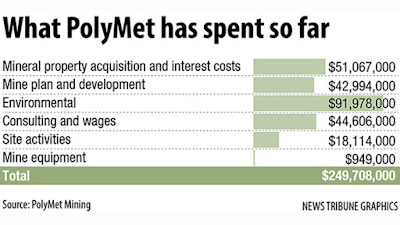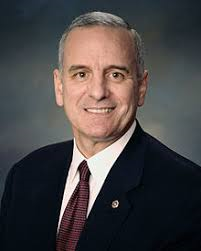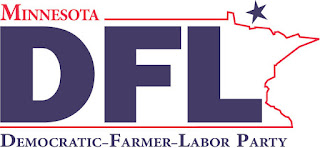Archive for the ‘Conservation Minnesota’ Category
The Trump administration is considering a rule change to something called “the blanket rule.” According to the article, it’s “probably an esoteric issue to most Americans, but to landowners and businesses, primarily in the Western U.S., the ‘blanket’ extension of ESA protections to “threatened” species has punished them for decades. A ‘take’ of a protected species can bring massive civil and criminal penalties. ‘Private property owners’ incentives are key because most endangered species depend on private land for most of their habitat,’ Wood said. ‘This reform will improve those incentives and make it easier for states, property owners, and environmentalists to work together on innovative conservation plans.’ The U.S. Fish and Wildlife Service extended “take” protections to species listed as ‘threatened’ under the ESA, despite Congress wanting federal agents to regulate “threatened” species different from those classified as ‘endangered.'”
When the ESA was enacted, Congress’s intent was to protect endangered species, which is defined as “any species in danger of extinction.” Meanwhile, threatened species are defined as “on the brink of becoming endangered.”
Its provisions give the Interior Department the power to determine what species are endangered and then to list them publicly. It makes it illegal to capture, kill, transport, sell, buy, possess, import or export any of the listed plants or animals. There is a separate category for “threatened” species, those organisms that are on the brink of becoming endangered. They are equally protected, except that scientists may take specimens when necessary for vital research.
In the United States the Office of Endangered Species currently lists 51 plants and 143 animals as endangered and 7 plants and 38 animals as threatened. To prevent the import or trade of endangered species native to foreign countries, the office lists 402 foreign animals as endangered and 16 animals and a plant as threatened.
The goal of the ESA is to properly manage plant and animal species so they’re no longer endangered or threatened.
Here in Minnesota, the ESA was critical in turning around the timber wolf population. At one point (the late 1960s and early 1970s), only a few families of timber wolves existed in Minnesota. After proper management, the timber wolf population, through cautious management, was rejuvenated to the point where there were open hunting seasons on the great grey wolf. That’s a legitimate success story. That should be the goal of management policies for all endangered or threatened species.
Instead, the ESA has been used as a weapon against developers. It’s time to de-weaponized the ESA and return sanity to development projects. That will be a difficult task. Environmental activist organizations like the Sierra Club, Conservation Minnesota and others have used the ESA to throttle projects. They won’t give up without a lengthy court fight.
Rejecting the blanket rule won’t fix the law but it’s a positive first step.
Friday morning, the Minnesota Department of Natural Resources “released a draft permit to mine Friday morning for PolyMet Mining” in what’s being called “a major step forward for what’s poised to be the first copper-nickel mine in the state.” While this isn’t the final step needed to mine, “the draft permit, which includes conditions the state would place on the Canadian mining company, signals the state is comfortable the mine, as proposed, can meet environmental standards and provide significant financial assurances to pay for any needed mine cleanup.”
While that’s a major step forward, the project still faces additional hurdles before construction can start. The next step allows the public “to weigh in on the draft permit, including at two public hearings scheduled Feb. 7 in Aurora, on the Iron Range, and Feb. 8 in Duluth. The DNR will also accept formal objections and petitions for special contested case hearings on the permit before a state administrative law judge.” After that, the MPCA “also plans to release draft water quality and air quality permits, two additional major permits PolyMet needs to obtain before it could open its proposed mine and processing plant near Babbitt and Hoyt Lakes.” That still isn’t enough to open the mine:
Environmental groups have already filed four lawsuits, most challenging a proposed land exchange with the U.S. Forest Service, and more suits are expected if the state eventually grants PolyMet permits. If the DNR calls for evidentiary hearings before an administrative law judge to gather testimony on aspects of the mining plan that are disputed by environmental groups and Indian tribes, that could tack on another 6 to 9 months to the regulatory process.
A vote for a DFL governor is a vote for continuing the status quo. In this instance, this process started in 2004 with the “Initial Environmental Review.”
According to this article, which was written on “Dec. 16, 2015”, PolyMet spent $249,708,000 in its attempt to get the mine operational:
Anyone that thinks spending $250,000,000 is reasonable to get approval for a mine hates mining and miners. The DFL and their front groups (think Sierra Club, Conservation Minnesota and Campaign to Save the Boundary Waters) might think that’s reasonable but sane people don’t. If anyone wants to know why entrepreneurs are leaving Minnesota, the regulatory climate is a major reason. There’s nothing reasonable about it.
Technorati: PolyMet, MPCA, EIS, Permitting Process, Sierra Club, Campaign to Save the Boundary Waters, Conservation Minnesota, Regulations, Lawsuits, DFL
Now that Gov. Dayton has officially picked Lt. Gov. Tina Flint-Smith to replace Sen. Franken in the U.S. Senate, it’s time to introduce Ms. Flint-Smith to Minnesotans. That’s the purpose behind Briana Bierschbach’s article attempts to do. Ms. Bierschbach’s article describes Ms. Flint-Smith as “a behind-the-scenes operator in DFL political circles who rose to the lieutenant governor job”, adding that “Smith said she’d decided against running for governor. But now, she plans to serve out Franken’s abbreviated term and run next fall to take his place in the United State’s Senate.”
TRANSLATION: Sen. Schumer essentially ordered Gov. Dayton to pick someone who was willing to do more than serve as a placeholder until this November’s special election. Simply put, Sen. Schumer gave Lt. Gov. Smith a set of marching orders and she complied.
The article continues, saying she “quickly rose within DFL circles and moved on to work on several statewide races, including Walter Mondale’s last-minute bid for the U.S. Senate in 2002 after the death of Paul Wellstone. Shortly after that race, she was recruited to be the vice president of external affairs at Planned Parenthood of Minnesota, North Dakota and South Dakota, leaving that job in 2006 to serve as Minneapolis Mayor R.T. Rybak’s chief of staff and eventually run his campaign for governor in 2010.”
The truth is that she’s just as hard left as Al Franken. She’s anti-mining and anti-blue collar worker. She hasn’t shown any interest in completing the Enbridge Pipeline. Smith hasn’t lifted a finger to get PolyMet operational. Further, she’s done pretty much what Alida Messenger has told the Dayton administration to do. This video essentially tells Minnesotans that DFL policies have failed Minnesotans:
Listen to this litany of paradoxes:
“I’ve heard stories from families who are working 2 full-time jobs and are still struggling to find a good place to live. Minnesota has some of the best schools but I have talked to moms who are faced with driving 60 miles every day to get their children to a good pre-school. Minnesota has more people with health insurance than almost any other state, yet I have talked with farmers who have lost access to their long-time doctors and can’t afford the health insurance premiums. Minnesota iron ore built this country yet I have talked with Rangers who are worried about the future of their small towns. Minnesota is often named as one of the best states for women yet even here, women still earn less than men and women of color and Native American women have even fewer opportunities. (sigh) We have so much opportunity in this state and in this country but we have so much work to do to make sure that that opportunity is broadly shared.
Let’s go through that list. First, DFL taxes and regulations have killed capital investments, thereby killing jobs. The DFL doesn’t trust in capitalism, which is why there’s an outmigration of people from Minnesota to Iowa, North Dakota, Texas, Utah and Georgia. According to the state demographer, this trend isn’t all retirees. It’s prevalent through all age groups.
Next, the DFL’s metro-centric policies have hurt people living in rural Minnesota. Don’t blame this on Republicans. Republicans have fought with Gov. Dayton and Lt. Gov. Smith for rural Minnesota’s priorities. Next, Lt. Gov. Smith hasn’t lifted a finger to make PolyMet operational. If she gave a damn about the Iron Range, she would’ve fought for the Iron Range. Smith hasn’t fought for the Range because she’s a close friend of Alida Messenger, the most anti-mining DFL activist imaginable. I hope Rangers aren’t fooled by Smith’s faux empathy. Smith doesn’t empathize with Rangers. She’s visited the Range but that was a strictly a photo-op.
Another thing that Smith shouldn’t get away with is her criticism of the ACA/MNsure. She was an integral part of getting that enacted into law as Gov. Dayton’s Chief-of-Staff. It’s indisputable that Smith’s policies have hurt Minnesotans. Finally, Smith was Gov. Dayton’s trusted ally long before he was elected. She isn’t just a trusted ally. She’s the architect of Gov. Dayton’s campaign.
I don’t doubt that Lt. Gov. Smith will try to project an image similar to Sen. Klobuchar’s. That’s smart politics. It’s also exceptionally dishonest. Smith is more of a centrist than them pervert she’s replacing.
Technorati: Mark Dayton, Tina Flint-Smith, Al Franken, Chuck Schumer, Alida Messenger, Environmental Activists, DFL, Iron Range, Rural Minnesota, Capitalism
This article highlights the thinking of the anti-mining special interests. It also highlights the attempts by the DFL to distance themselves from the dominant wing of the DFL.
First, the article quoted Becky Rom’s and Reid Carron’s disparaging quotes about the mining industry. Carron is quoted as saying “Resentment is the primary driver of the pro-mining crowd here. They are resentful that other people have come here and been successful while they were sitting around waiting for a big mining company. They want somebody to just give them a job so they can all drink beer with their buddies and go four-wheeling and snowmobiling with their buddies, not have to think about anything except punching a clock.” Meanwhile, Rom is quoted as saying that “Ely council member and mining advocate Dan Forsman ‘drives to the mine in his truck, comes home and watches TV, and he doesn’t know this world exists,’ referring to the Boundary Waters Canoe Area Wilderness.”
Thanks to social media (and websites like LFR), their comments went viral. One of the first to react was “Jason George, political and special projects director for the International Union of Operating Engineers Local 49, [who] said ‘it disgusts me. There is no other way to put it. In my opinion, and in my experience sitting through public hearing after public hearing listening to environmental activists dismiss and belittle construction jobs, the sentiments expressed by Rom and Carron very accurately reflect the way most anti-mining, anti-pipeline, and anti-development groups really feel about the hardworking people of northern Minnesota. Minnesota’s blue-collar workers, the men and women I am proud to fight for, deserve better.'”
Mike Kinsley once infamously said that a gaffe is when you accidentally tell the truth. That’s what happened here. Carron and Rom made the mistake of saying what they truly felt to a magazine reporter from New York. They never thought Minnesotans would hear their statements. Here’s the guilty (married) couple:
DFL Party Chairman Ken Martin, in his attempt to keep the DFL together, embarrassed himself:
Amid an intraparty battle between pro-mining union members and environmental interests that have stepped up opposition to copper-nickel projects, Martin said “These judgmental comments wrongfully disparage thousands of hard-working Minnesotans. There’s no question that the issue of mining in northern Minnesota is a contentious one. But there’s no room in the debate for sharp-tongued attacks on Minnesotans who work hard every day to provide for their families and support our state’s economy. Here in Minnesota, we value civility. We treat each other with respect. We must keep this debate healthy, productive, and focused on the issue at hand. Because at the end of the day, we all want the same thing: a better life for our family and a brighter future for our state.”
That’s outright BS. Mining isn’t a contentious issue. I’ll stipulate that it’s a complicated issue for the DFL but that’s only because they’re too spineless to stand up to the dominant anti-mining wing of the DFL. If Martin had a spine, he would’ve forcefully criticized Rom for saying that “anti-mining forces would gain an advantage ‘one funeral at a time.'”
The Bible says that you “can’t serve two masters.” That’s what Martin is attempting to do. Using a different metaphor, he’s trying to mix oil with water. Good luck with that.
In an apology released to a Duluth television station and later sent to the Echo, Rom and Carron wrote that Carron’s was “disrespectful and untrue.” “First and most important, the statement is untrue with respect to the thousands of people across northeastern Minnesota who work hard every day and who believe that developing copper mines will provide worthwhile economic opportunities for them, for people they care about, and for our communities,” they wrote. “We respect people who get up at 4:30 am to drive to work in Minnesota’s taconite mines. Second, the statement is untrue because it does not reflect what we think. Living in the Ely community, we depend on people all the time who we know hold a different view than we do on whether copper mining would be a good thing. When we do business with them, they are helpful and generous, and we treat each other with mutual respect.
“For Reid to say that people like that are sitting around waiting for a big mining company to give them a job or Becky to question if Dan Forsman has been into the Boundary Waters is disrespectful. We apologize for these statements.”
I don’t trust this apology. Why trust someone that’s lied to newspapers about how they tried to secretly sabotage an entire industry?
Finally, check out this quote:
“Reid Carron’s description of people who support copper-nickel mining is nothing short of disgusting,” said Paul Austin, executive director of Conservation Minnesota. “This is an important conversation that requires each of us to work to understand each other’s perspectives on the issue so we can reach a positive resolution. There is no place for demeaning fellow Minnesotans.”
Technorati: Becky Rom, Reid Carron, Ken Martin, Environmental Activists, Friends of the Boundary Waters, Paul Austin, Conservation Minnesota, Anti-Mining, DFL, Jason George, Unions
This article highlights the fact that environmental activists aren’t trustworthy. For years, we’ve heard activists from the Sierra Club, Conservation Minnesota and Friends of the Boundary Waters tell us that the sulfur embedded within the copper deposits will stunt the growth of wild rice while poisoning the water.
Pro-mining people questioned the environmental activists’ claims throughout. We’re finding out why the pro-mining people were skeptical. First, before getting into that, I wrote about a University of Minnesota study on wild rice growth a couple years ago. The study reported that rice growth was stunted except when there was a high concentration of iron in the water. The study found that iron mitigated the damage sulfur caused to the rice.
I said back then that there was a pretty high probability that water flowing through the Iron Range would have high concentrations of iron in it. Back then, I quoted from an LTE that said “In 2013 the state hired the University of Minnesota to do a scientific study of the effects of sulfates on wild rice and to determine what the standard should be. Also the Minnesota chamber hired an independent laboratory to do the same. Both studies agree that sulfate is not toxic to wild rice. The studies also found that if sulfates turn to sulfides it does slow the growth of wild rice. However if there is iron present in the water, iron combines with the sulfides and doesn’t allow the sulfides to affect the wild rice.”
This picture is worth thousands of words of anti-mining spin:
The caption reads “A Picture Worth a Thousand Words: Much has been written lately about how sulfate discharges from mines may stunt wild rice growth. Here is a photo of wild rice on Birch Lake (Dunka Bay) ‘stunted’ by sulfate discharges in the Dunka River from the Dunka and Northshore mines. Why are new studies needed when actual results already exist? Photo by Pete Pastika.” Good question, Pete. Personally, I think the time for studies is over. The time for Minnesota to approve the final permits is now.
Technorati: Sulfide Mining, Conservation Minnesota, Friends of the Boundary Waters, Sierra Club, PolyMet
In the first 4 parts of this series (found here, here, here and here), I focused on different facets of the inadequacies of the Dayton-Rothman Commerce Department. I categorized each of the shortcomings and culprits. Most importantly, I identified the opportunities that the Dayton-Rothman Commerce Department missed and why.
This article will pull everything together so we can put together a less hostile, more business-friendly set of policies that doesn’t sacrifice the environment. First, we’ll need to streamline the regulatory review process so hostile environmental activists don’t have multiple opportunities to throttle key infrastructure projects. Whether we’re talking about killing the Sandpiper Pipeline project, the constant attempts by the Sierra Club, Conservation Minnesota and Northeastern Minnesotans for Wilderness to kill both the Twin Metals and the PolyMet projects or the Public Utilities Commission and the Dayton-Rothman Commerce Department, it’s clear that the DFL is openly hostile to major infrastructure projects.
It’s long past time to get the PUC out of the public safety/transportation business. Similarly, it’s time to get the Commerce Department out of the environmental regulatory industry. Public safety and transportation belong in MnDOT’s purview, not the PUC’s. Environmental regulations need to be significantly streamlined, then shipped over to the DNR. There should be a period for fact-finding and public comment. There should be the submitting and approval/disapproval of an Environmental Impact Statement and the submitting and approval/disapproval of an Economic Impact Statement.
Further, laws should be changed so that there’s no longer a requirement to submit an application for a “certificate of need.” In effect, that’s a bureaucratic regulatory veto of major infrastructure projects. That isn’t acceptable. There should be a time limit placed on the bureaucrats, too. They should have to accept or reject applications within a reasonable period of time. That’s because regulators have sometimes used delaying tactics to throttle projects without leaving a paper trail. It’s also been used to deny companies the right to appeal rulings. (If there isn’t a ruling, there isn’t an appeal.)
Third, streamlining the review process limits the opportunities for environmental activists to kill projects like those mentioned above. There’s a reason why it’s called the Commerce Department, not the Department of Endless Delays and Excessive Costs, which is what it’s become. Eliminating the PUC’s oversight responsibilities, especially in terms of approving certificates of need, will eliminate the impact that environmental activists serving on that Board can have in killing or at least delaying major infrastructure projects.
Fourth, it’s important that we bring clarity and consistency to this state’s regulatory regime. The system Minnesota has now breeds uncertainty. That steals jobs from Minnesota because companies attempt to avoid Minnesota entirely whenever possible. While we want to preserve our lakes, rivers and streams, we want to preserve our middle class, too. The environment shouldn’t be put on a pedestal while communities die thanks to a dying middle class.
I’ve seen too often how once-proud parts of Minnesota that have a heavy regulatory burden have seen their middle class essentially disappear. Cities like Virginia and Eveleth come to mind. It’s immoral to give a Twin Cities agency the authority to kill Iron Range communities. That’s literally what’s happening right now.
For the last 7 years, Gov. Dayton has run an administration that’s of, by and for the environmental activist wing of the DFL. If you work in a construction union, you haven’t had a great run. That isn’t right. People who work hard and play by the rules should be able to put a roof over their family’s head, set money aside for their kids’ college education and save for their retirement. For far too many people, that hasn’t happened recently.
The next Republican governor should implement these changes ASAP. It’s time to destroy the Dayton ‘Hostile to business’ sign and replace it with an ‘Open for business’ sign. It’s time to get Minnesota government working for everyone once again.
Technorati: Mark Dayton, Public Utilities Commission, Mike Rothman, Environmental Activists, Certificate of Need, Special Interests, Regulatory Regime, DFL, Infrastructure, Sandpiper Pipeline Project, Enbridge Line 3 Pipeline, Construction Unions, Transportation, Public Safety, Republicans
Over the years of covering PolyMet, I’ve heard some pretty flimsy arguments. Few, though, have been as flimsy as Sen. Erik Simonson’s argument. According to the article, Sen. Simonson said “The ‘company’ wants the process sped up. Since when does our government work for foreign corporations?” Considering the fact that PolyMet has been engaged in this process for almost a dozen years, don’t they have the right to expect the government to expedite the process while ensuring that the laws are being faithfully obeyed?
Thus far, DFL anti-mining special interest groups have done everything in their power to prevent mining. Among the tactics they’ve deployed in their war of attrition against PolyMet and Twin Metals, organizations like Friends of the Boundary Waters, Northeastern Minnesotans for Wilderness, Sustainable Ely, all with direct ties to Becky Rom, requested a programmatic environmental impact statement, aka a PEIS. Conservation Minnesota have put together websites that spread misinformation about non-ferrous mining. Organizations like the Sierra Club and the Minnesota Center for Environmental Advocacy, aka MCEA, have sued PolyMet as a delaying tactic. At least one Indian tribe tried getting PolyMet stopped on the grounds that their mining operations might damage wild rice growth. (This despite a University of Minnesota study showing that high concentrations of iron in the water mitigates most of the potential damage to rice.)
The number of methods and venues used by the DFL’s anti-mining special interest organizations to prevent mining is frightening. I wouldn’t doubt that a state senator from the Twin Cities say that PolyMet is trying to rush through the process. To hear a state senator from CD-8 essentially say that PolyMet is trying to cheat the system is disgusting. If the local DFL doesn’t primary this idiot, we’ll have proof positive that the DFL hates miners. Here’s one of the anti-mining leaders:
Here’s another:
Technorati: PolyMet, Erik Simonson, Becky Rom, Mining, Sierra Club, MCEA, Friends of the Boundary Waters, Litigation, Iron Range, DFL
This Duluth News Tribune editorial highlights the fact that another DFL front group is attempting to kill the PolyMet mining project. According to the editorial, “a group calling itself the Duluth for Clean Water Action Team contacted councilors, asking them to sign on to a letter requesting once again that a contested case hearing be ordered by Gov. Mark Dayton and DNR Commissioner Tom Landwehr so ‘that the claims of both project proponents and opponents (can) be subjected to the highest possible scrutiny.'”
The editorial continues, saying “A reasonable, desirable goal — but it actually already has happened. Over the last 10 years-plus, PolyMet’s plans have been studied and analyzed, their every detail considered to assure compliance with state and federal regulations that are some of the most stringent in the world. It was an exhaustive and detailed environmental review that worked. When the company’s plans didn’t measure up, they were sent back for revisions and wholesale changes. A safer, sounder plan emerged as a result.”
Before Gov. Dayton was sworn in as governor, I wrote this post, titled “Attrition, not litigation.” During Gov. Dayton’s entire term in office, he’s been as active as a potted plant when it comes to supporting miners. He’s sat still while environmental activists like Duluth for Clean Water Action Team, the Sierra Club, the Northeastern Minnesotans for Wilderness and Conservation Minnesota did their utmost to kill the PolyMet mining project.
These organizations’ favorite tactics are persistent litigation and other stalling tactics. This paragraph pretty much says it all:
It’s hard to imagine what new evidence could be brought at a contested case hearing that hasn’t already been thoroughly researched, considered, vetted, and, where appropriate, implemented. An administrative law judge hardly would be an environmental expert or an authority on the science or business of mining. Those experts already have weighed in, prompted improvements to the plans, and signed off.
It’s time to start building the mine. The region needs it economically. The regulating agencies have said that it will be operated properly.
If the DFL wants to admit that they hate miners, they’re welcome to admit that. Otherwise, it’s time for them to get the hell out of the way so the Iron Range can prosper again.
There’s been lots of celebrating on the Range after Resolution 54 got defeated Saturday. This article said that Jason Metsa thinks that the vote is “a clear indication of where the party is at.” Then Metsa admitted that “the issue will be coming up again.”
First, the Range DFL survived Saturday, partially because all parts of the state were represented at the meeting. Anyone that thinks that John Marty will give up his anti-mining crusade anytime soon is kidding themselves. New incoming House Minority Leader Melissa Hortman hasn’t announce that she’ll take a more centrist, pro-mining position now that she’s the top-ranking Democrat in the House.
That’s before talking about whether organizations like the Sierra Club, MCEA or Conservation Minnesota (which gets significant funding from Alida Messenger) will stop bringing lawsuits against PolyMet. MCEA’s mission is to file lawsuit after lawsuit against mining companies or utilities. Winning the lawsuits isn’t MCEA’s goal. Their goal is to wear down the investors until those investors quit. I wrote about that tactic in this post, which I titled Attrition, not litigation.
Third, defeating Resolution 54 isn’t a victory because it didn’t approve a single permit for PolyMet or Twin Metals. The last I looked, Gov. Dayton hasn’t relented in saying no to the initial permits for the Twin Metals mining project.
Fourth, the DFL hasn’t lifted a finger to streamline the permitting process. I won’t trust them until they support permitting reform and regulatory relief. Even then, I’ll remain skeptical because these guys won’t permit the DFL to do real reforms:
The lede in this article sounds a triumphant tone. The opening says “Labor Democrats decided to fight Saturday and won a major victory for the party’s future on the Iron Range.” While it’s a procedural victory for the Range, it isn’t a major victory if you’re judging it by whether anything changed as a result of the vote.
In defeating Resolution 54, the Range Delegation kept the language of the resolution out of the DFL state party platform. That shouldn’t be mistaken for defeating the environmental activist Metrocrats. It shouldn’t be mistaken as proof that Gov. Dayton will approve any permits for PolyMet. Defeating Resolution 54 doesn’t mean that the DFL is suddenly open to mining.
The DFL loves bogging things down with regulations, regulators and lawsuit. The thing Iron Rangers should ask themselves seems unrelated at first. This past winter, the Public Utilities Commission (PUC)decided to look into the Sandpiper Pipeline project. Specifically, they took jurisdiction over whether the pipeline path should be rerouted. The first question that should be asked is straightforward: what does the agency that regulates electricity rates have to do with infrastructure permitting? It isn’t like the PUC was the first regulatory agency to review the Sandpiper Pipeline’s potential impact on its environment. The point is that the PUC took jurisdiction to hinder the permitting process.
Here’s another important question that the DFL hasn’t answered: why didn’t Gov. Dayton scream bloody murder when the PUC hijacked jurisdiction on the Sandpiper Pipeline project? In 2013-14, when the DFL had total control of the legislature and had a friendly DFL governor to work with, why didn’t they streamline the permitting process? Might it be because they prefer a permitting process that’s complex and convoluted?
Ask PolyMet’s investors whether these DFL-supporting organizations haven’t used the same tactics to kill PolyMet. If they’re being honest, they’d say that’s the exact playbook that’s been used against them. Until the pro-mining part of the DFL becomes the dominant part of the DFL or until pro-mining voters switch to the GOP, there won’t be a change in the outcome. Saturday’s vote was all show. In the real world, it meant nothing. The anti-mining wing of the DFL still rules the DFL.










